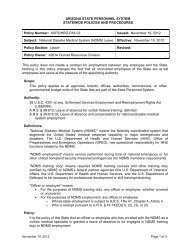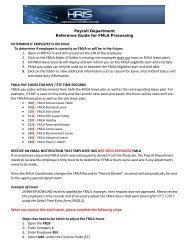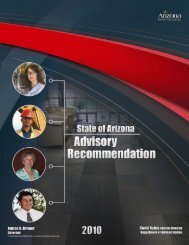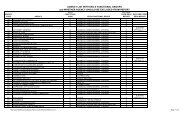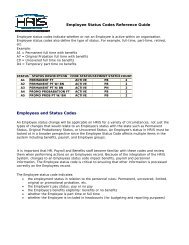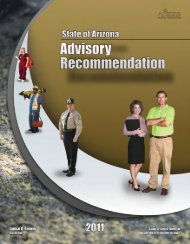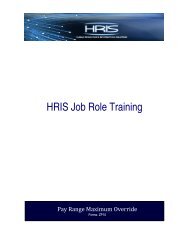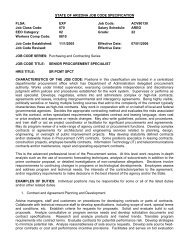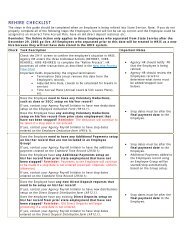2009 Salary Recommendation - Arizona Human Resources
2009 Salary Recommendation - Arizona Human Resources
2009 Salary Recommendation - Arizona Human Resources
- No tags were found...
Create successful ePaper yourself
Turn your PDF publications into a flip-book with our unique Google optimized e-Paper software.
In 2008 the state was deep in the throes of the worst budget crisis in recent history. TheDepartment of Administration again did not recommend a specific amount for salary increasesdue to the uncertainty of the budget situation in September 2008. The FY 2010 budget did notprovide for any salary increases.<strong>Recommendation</strong>Year(Calendar Year)Figure 1History of the State’s Compensation AdjustmentsBudgetYear(Fiscal Year)AverageCovered<strong>Salary</strong>General <strong>Salary</strong>AdjustmentsMerit orPerformanceAllocations forSelected Classes1996 1998 $26,874 2.5% 2.5% Merit Yes1997 1999 $28,249 -0- 2.5% Merit Yes1998 2000 $29,208 -0- 2% Merit Yes1999 2001 $29,725 -0- 2% Merit Yes2000 2002 $30,331 $1,4502001 2003 $31,824 -0-2002 2004 $31,859 -0-2003 2005 $32,059 $1,000 Yes2004 2006 $32,897 1.7% Yes2005 2007 $36,195 $1,650 2.5% Perf Pay Yes2006 2008 $38,023 3.0% 0.25% Perf Pay Yes2007 <strong>2009</strong> $38,097 -0-2008 2010 $38,478 -0-Source: Joint Legislative Budget Committee FY2008 Appropriations Report. Merit Adjustment figures represent the percentage allocated toan agency's personnel services base. Allocations for Selected Classes are provided to address specific job classes or specific agencyneeds addressed by legislation. Average Covered <strong>Salary</strong> data are based on regular covered employees in agencies within the ADOAPersonnel System calculated as of the end of July; figures for FY 2007, 2008, <strong>2009</strong>, and 2010 have been adjusted to account forperformance pay.CURRENT STATE OF COMPENSATIONThe job market is a constantly moving target, and state salaries must continually be analyzed toassess the competitive position of the state with respect to the market. The most recent analysisof market competitiveness suggests the market exceeds state salaries by an estimated 9.5%.Figure 2 below illustrates the relative difference between state salaries and the market.30%25%20%15%10%5%0%19 .6 % 20.6% 22.5%22.5%19931994Figure 2 – Percent Needed to Get to Market25.7%22.5%17 .5 %2005 Goal = within 5% of market16 .4 % 16 .3 %13 .2 % 14 .0 %11.5 %199519961997199819992000200120022003321.7%20.4%14 .9 %9.5% 9.5%7.1%20042005200620072008<strong>2009</strong>2010Source: Percent Needed to Get to Market is based on a suite of compensation surveys, includingthe <strong>Arizona</strong> Compensation Survey (previously refered to as the Joint Governmental <strong>Salary</strong> Survey).Average State Employee Salaries are based on employees in the ADOA Personnel Systemcalculated as of the beginning of the fiscal year (July 1). Estimates for FY <strong>2009</strong> have been adjustedto account for performance pay.
FUTURE CONSIDERATIONSThere are a number of factors that must be considered in developing a strategy to ensure statesalaries become competitive, including predictions of future market movement.Market MovementWhen reviewing information from compensation consulting firms, employers are asked topredict or project the increases that will occur in the future. Several surveys were analyzed toestimate market movement in the coming year (Figure 3). It is worth noting that in 2007 and2008, salary increases were typically in the range of 3-4%. <strong>Salary</strong> increases in <strong>2009</strong> were closerto 2%, with one report included the following comment; “Pay raises are the smallest in decades,surveys show.” While organizations nationally and regionally estimate increases averaging 2.5%in 2010, of particular importance to this report, the estimated increase for public sectororganizations in 2010 in <strong>Arizona</strong> is 0.5%. Note that these are averages, and some organizationsare projecting decreases or no salary increases for 2010.Figure 3 – Actual and Projected <strong>Salary</strong> IncreasesReference2007ActualIncrease2008ActualIncrease<strong>2009</strong>ActualIncrease2010ProjectedIncreaseNational - Mercer 3.9% 3.8% 2.3% 2.7%National - WorldatWork 3.9% 3.9% 2.2% 2.8%Regional - CompData N/A 3.6% 2.5% 2.7%<strong>Arizona</strong> – Public & Private 1.9% 1.9%3.9% 3.6%<strong>Arizona</strong> – Public Sector Only1.1% 0.5%Phoenix - WorldatWork N/A 3.8% 1.8% 2.8%State of <strong>Arizona</strong> 3.25% 0% 0% TBDSource: National data from Mercer, WorldatWork, and CompData websites; <strong>Arizona</strong> data from Economic Research Institute and<strong>2009</strong> <strong>Arizona</strong> Compensation Survey; Phoenix data from WorldatWork.TurnoverThe separation rate of covered employees increased slightly in <strong>2009</strong> (Figure 4). This changesuggests a return to the ten year average of 16.2%. This figure makes an interestingsupplement to Figure 2 on page 3, which shows the trend of state salaries compared to themarket. When state salaries were closest to the market (2000 and 2001), the turnover ratesdropped sharply in the following years. After that time, as state employee salaries began to fallsignificantly behind the market, the state experienced ever increasing turnover rates. As thestate’s market competitiveness returned in 2007 and 2008, turnover rates again begandecreasing in the following years. It remains to be seen if state salaries are able to remaincompetitive with the market, whether turnover rates will continue to be held at current levels.24%22%20%18%16%14%14.3%Figure 4 – Separation Rates of Covered Employees15.9% 16.5% 15.2%12.7%21.2%17.9%17.3%15.4% 15.6%14.8%14.9%12%10%1998 1999 2000 2001 2002 2003 2004 2005 2006 2007 2008 <strong>2009</strong>Source: <strong>2009</strong> State of <strong>Arizona</strong> Workforce Report. Separations are defined ascovered employees leaving state service during the fiscal year (July 1 to June 30).4
Of particular interest in <strong>2009</strong> was the dramatic andsignificant reduction in the size of thegovernment’s workforce. The number of filledpositions in the ADOA Personnel Systemdecreased by 8.8%, to the lowest levels in thepast decade (Figure 5). As a result of budgetaryconstraints, in addition to implementing astatewide hiring freeze, many agencies wererequired to implement layoffs and reductions inforce. Thus, although total turnover may haveslightly increased in <strong>2009</strong>, the rate of voluntaryresignations experienced a 25% reduction, whilethe rate of involuntary terminations increased bynearly 200% from the year before.Figure 5 – Employee Headcount – ADOA Personnel System40,00038,488 38,50637,84938,00037,29337,30636,67436,44235,847 36,030 36,00034,00033,23632,00030,0002000 2001 2002 2003 2004 2005 2006 2007 2008 <strong>2009</strong>Source: <strong>2009</strong> State of <strong>Arizona</strong> Workforce Report.Although turnover rates appear to be returning to historic averages, it is important to note that ingeneral, the state is experiencing higher turnover than most other states, and higher turnoverthan other local public sector employers (Figures 6 and 7).Figure 6 – Separation Rates of LocalPublic Employers - <strong>2009</strong>EmployerAnnualSeparation RatePhoenix 6.0%Tempe 7.4%Gilbert 9.4%Maricopa County 9.6%Pinal County 12.0%Mesa 13.6%Yuma County 15.0%State of <strong>Arizona</strong> 15.6%Source: Individual Contacts, Information presented is the mostcurrent available. Average illustrates simple average of localemployers excluding the State of <strong>Arizona</strong>.Figure 7 – Separation Rates of StateGovernments - <strong>2009</strong>StateAnnualSeparation RateMinnesota 5.6%Wisconsin 7.0%Oregon 7.3%Colorado 8.5%South Dakota 10.5%Nevada 10.6%Missouri 10.7%Wyoming 12.9%Indiana 13.3%Nebraska 15.6%<strong>Arizona</strong> 15.6%Texas 17.3%Source: Individual Contacts and web pages; information presented isthe most current available.When an employee leaves an organization, the employer usually experiences substantial costs.Costs to the employer may include decreased productivity, costs of hiring a new employee,increased training time, and other indirect costs as well as reduced levels of service to thecustomer. The estimated total cost of losing a single person to turnover ranges from 30% oftheir yearly salary to 150%. The current turnover rate of 15.6% results in an estimated total costof nearly $48 million per year (<strong>2009</strong> State of <strong>Arizona</strong> Workforce Report).5
CONCLUSIONThe state made significant progress towards improving the position of state employee salariesrelative to the market during FY 2007 and FY 2008. The Executive and Legislative branchessent a clear message to state employees that salary issues were important, and the gapbetween state employee salaries and the market was reduced to the lowest level in nearly twodecades. Unfortunately, due to the economic challenges at the national and local levels, thestate did not allocate funding for salary increases in FY <strong>2009</strong>, and the market position of stateemployee salaries declined. As the economic conditions worsened through the past year, allindustries were affected, and although the state again did not allocate funding for salaryincreases in FY 2010, fortunately state salaries did not lose further ground compared with themarket.It is expected however, that when economic conditions begin to improve, the public sector willlag the private sector, and further erosion of state employee salaries may become evident.RECOMMENDATIONThe Department of Administration understands and appreciates the realities of the the currenteconomic situation of the state’s budget. When taken into consideration along with the health ofthe economy, both at a national and state level, and considering the estimated movement ofemployee salaries in the market, the Department is recommending to defer any salary increasesuntil budget conditions improve. As soon as it is fiscally possible, addressing issues of stateemployee compensation should be a priority and the goal of bringing salaries within 5% of themarket should be addressed.7



